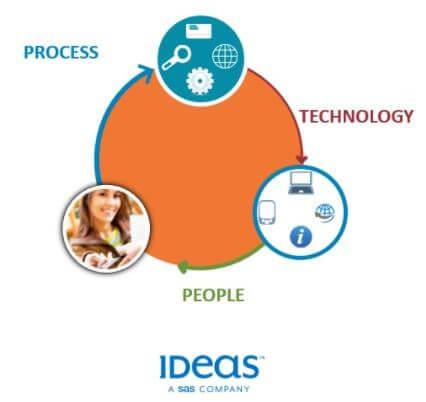Consulting Services answers recent client questions about hotel revenue management
Yuki Hu, IDeaS advisor in China, discusses how to get teams out of the silos and working more collaboratively—and more productively—as part of the larger organization.
Siloed teams are quite common in the hospitality industry. Often, you will see each department using their own key performing indicators (KPI) and distinct processes. One of the most common questions I get from hotel general managers is, “How can we get everybody on board to achieve total revenue optimization?” And, often, the revenue leaders will reply, “It’s nearly impossible to get every department to go along with a new way of thinking.”
Because of this struggle, I knew it was high time to discuss how to get everyone out of silos to work together cross-departmentally toward a better revenue management solution. At IDeaS, we believe successful revenue management requires three key elements: the right process, technology and people—working in tandem.

Let’s start your journey to optimal revenue results:
Step 1: Get everyone on the same page—without resistance
The “without resistance” part is the most important and typically the most difficult. Instead of different departments sharing different targets, a common goal should be created for the entire team. When a revenue leader comes to a food and beverage (F&B) director talking about revenue management, running promotions or changing the pricing structure, it may not always lead to a smooth discussion as the F&B team might have their own focus on guest satisfaction or food cost more than revenue itself. To solve this problem, we recommend hotel leaders set up a common goal, such as total RevPAR, total RevPAST or GOPPAR, instead of simply using RevPAR or Occ. Of course, you can always set additional KPIs for each department, using RGI, YOY percentage change or other benchmark KPIs (MPI and ARI) for your sales and marketing team while your F&B team would be using RevPASH (revenue per available seat per hour) as well. Although these individual goals are important, the key to total revenue optimization is to set one overarching goal for the entire team to strive for. We understand that from the regional level, it is still challenging for the executives of different chains to agree on the same standard definition to calculate GOP or total revenue. However, from the regional or hotel level, we can review these numbers internally.
Step 2: The revenue leader needs the right leadership
To achieve total revenue success, the revenue leader should be managed by the appropriate position and be fully equipped with related skill sets. For example, if a revenue leader reports directly to the director of sales and marketing, and the hotel’s performance is simply measured by RevPAR, then they likely will be focused strictly on rooms instead of other revenue streams. Once the revenue leader is managed by the appropriate position—for example, directly reporting to the GM and overlooking all revenue streams—it’s time to have all the departments come on board for deeper discussions of total revenue optimization. In that way, besides analytical skills, it is vital for a strong revenue leader to develop further communication skills to better cooperate with different departments.
Step 3: Go to the revenue meetings!
We recommend taking advantage of the revenue meeting on a regular basis and to involve each department to join in the strategic discussion, sharing and decision-making process, instead of simply focusing on specific areas of revenue that affect their individual departments. Keep in mind that the revenue culture is instilled in a company through an entire revenue team which includes the GM, DOSM, room sales, meeting and event sales, F&B, front office and finance teams—the list goes on and on—instead of just the revenue director or manger alone.
Last but not least: A well-designed and functional revenue system
IDeaS is the leading innovator and provider of revenue management solutions that ensure its clients remain leaders in their own markets. IDeaS has worked hard to find new and enhanced ways to optimize not only hotel room revenue through IDeaS RMS, G3 RMS, Forecast Management System and Pricing System, but also ancillary revenues through Smart Space by IDeaS and IDeaS Function Space Revenue Management systems.
As we look forward to a prosperous 2018, we anticipate that more hotel chains and properties will find their own ways to break the silos and, of course, get closer to the ultimate goal of total revenue and profit optimization.
Hey, don’t leave now—the fun is just beginning. Here are more industry insights making the rounds this week:
- Blockchain: Harnessing Its Potential in Travel: What the heck is “blockchain”? And why should the travel industry give a darn? Check out the new whitepaper from the maestros at Amadeus to learn about this emerging technology and its potential to transform your business.
- These Google Changes Will Rock Your Hotel’s World in 2018: “Okay, Google, what are you up to now?” Google’s impact on the hotel industry can’t be understated, and their potential to shake things up in the future should not be ignored. Catch up with the tech giant with the latest podcast from Fuel.
- 5 Secrets Locked Away in Your Hotel PMS Data: Is your hotel’s data hiding something from you? Probably, but we have ways of making it talk. Revinate gets tough with data interrogation tips for effective email marketing strategies in their recent blog.
- Why Listening to Your Guests Is the Key to Improved Operations Management: Forget “the customer is always right.” How about “the customer will take their money elsewhere if they’re not satisfied, so you better pay attention to them.” TrustYou speaks the truth about guest communication and feedback in their recent blog.
- Change Management Essentials for Revenue Leaders - August 20, 2019
- Bridging the Industry with Yuki Hu - November 7, 2018
- Bridging the Industry with Yuki Hu - August 29, 2018
